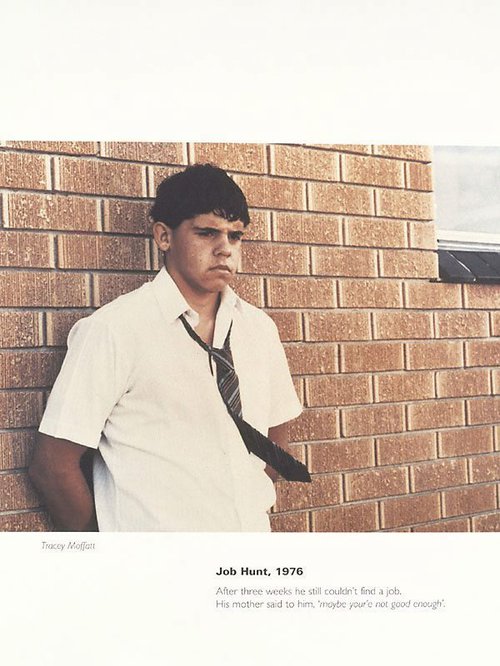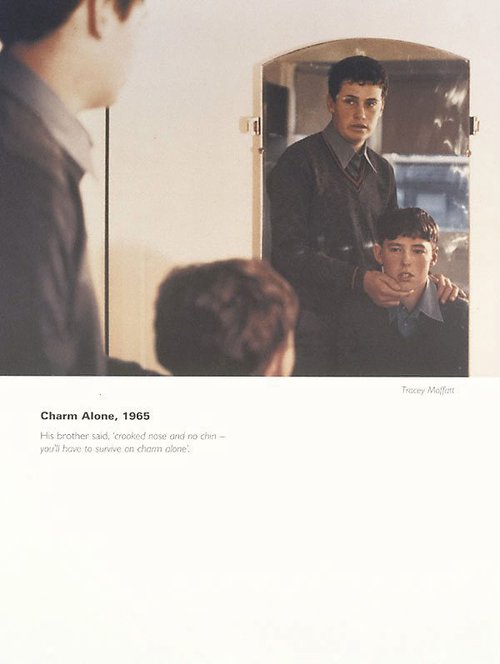-
Details
- Date
- 1994
- Media category
- Photograph
- Materials used
- photolithograph
- Edition
- 18/50
- Dimensions
- 80.0 x 60.0 cm sheet; 85.0 x 65.0 cm frame
- Signature & date
Signed and dated verso, "Tracey Moffatt '94".
- Credit
- Purchased 1996
- Location
- Not on display
- Accession number
- 128.1996.6
- Copyright
- © Tracey Moffatt. Courtesy of Roslyn Oxley9 Gallery, Sydney
- Artist information
-
 Tracey Moffatt
Tracey Moffatt
Works in the collection
- Share
-
-
About
‘Scarred for life I’ and ‘II’ are printed on thin off-white paper akin to scaled up pages from ‘Life’ magazine. The first series is of nine images, the second ten images. Originally designed to be pinned to the wall like street posters, Moffatt used photolithography (which was the most common form of printing used in newspapers and magazines in the 19th and 20th centuries) to print the works in faded colours, adding to their ephemeral effect. While ‘Life’ magazine in the 1950s and 1960s published photo-essays on major world events and presented different cultures to its primarily American audience, Moffatt takes the small yet traumatic humiliations of daily life – the sniping and jibing at difference, the feelings of inadequacy which may indeed scar us for life – and makes these stories equivalent in power.
‘Scarred for life’ is set in environments the very ordinariness of which contributes to the dramatic tension. Each suburban drama of familial slighting is at once horrifying as much as it is amusing because of its very mundanity. The viewer recognises similar events from their own past, or strange events that they have witnessed and not quite understood. Most of the tableaux take the point of view corresponding to or mirroring the wounded subject. It is this wounding and lack of resolution which then binds the viewer of the work to the viewer of the event described.
‘Scarred for life I’ and ‘II ‘are unusual in Moffatt’s oeuvre because of the captions. While the words are compelling, they don’t explain the images, indeed they tend to add to their enigmatic nature as though more information is a further dead end. This works directly against the received notion of photographic captioning as necessarily directing understanding. In ‘Scarred for life’ the intricate webs of thought, action, word and image capturing the chasm of ongoing trauma are presented. Moffatt has said that this series may be a continuing project as ‘everyone has a tragic tale to tell’.1
1. Tracey Moffatt interviewed by M Cathcart, 'Arts Today', ABC Radio National, Sydney, 31 Jul 2000
© Art Gallery of New South Wales Photography Collection Handbook, 2007
-
Exhibition history
Shown in 2 exhibitions
Australian Perspecta 1995, Art Gallery of New South Wales, Sydney, 03 Feb 1995–26 Mar 1995
From the Street - Photographs From the Collection, Art Gallery of New South Wales, Sydney, 27 Apr 1996–14 Jul 1996
-
Bibliography
Referenced in 6 publications
-
George Alexander, Photography: Art Gallery of New South Wales Collection, 'Tableaux - memento mori - screen culture', pg.313-335, Sydney, 2007, 327.
-
George Alexander, Contemporary: Art Gallery of New South Wales Contemporary Collection, 'Popism and screen culture', pg.204-245, Sydney, 2006, 208.
-
Judy Annear, From the street: photographs from the collection, Sydney, 1996. no catalogue numbers
-
Centre national de la photographie and Centre Cultural de la Fundació "la Caixa", Tracey Moffatt, Paris, 1999, 45 (colour illus.), 47 (colour illus.).
-
Gael Newton and Tracey Moffatt, Tracey Moffatt Fever Pitch, Sydney, 1995, 85 (colour illus).
-
Gael Newtown, Australian Perspecta 1995, 'Tracey Moffatt', pg. 70-71, Sydney, 1995, 70.
-




